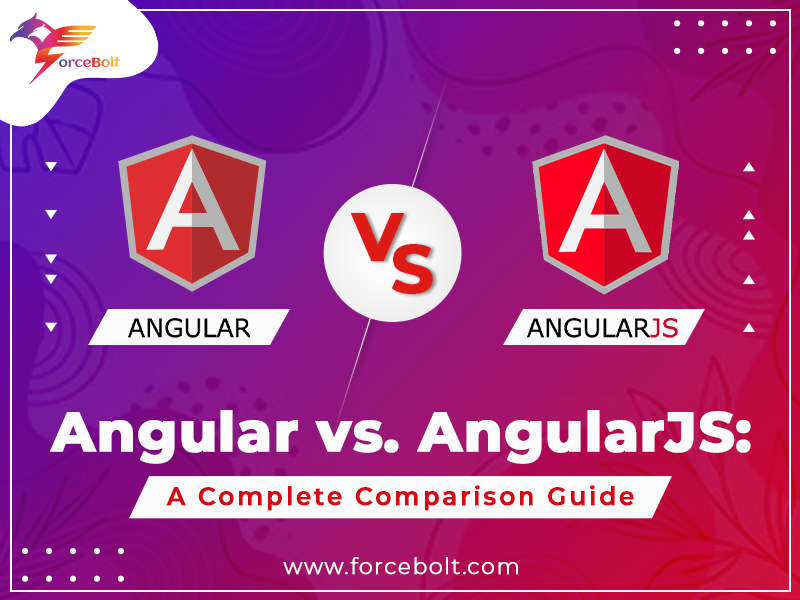Sharing is caring!
In today’s digital era, companies are constantly looking out for strategies to help them stand out in this fiercely competitive environment. Web and mobile apps have become a prerequisite and a helpful marketing tool for any full-stack development agency to be successful. To create easy-to-use, successful applications, it is vital to have the right mobile app development framework based on technologies, platforms, and databases.
Among the best Javascript frameworks, Angular and Angular js are the most popular frameworks used for web development at the forefront. However, before we discuss the differences between Angular and AngularJS, let’s look at the basics.
Undoubtedly, Angular is a well-known framework for building web applications among most front-end developers.
AngularJS is an open-source JavaScript framework for developing front-end applications. Its subsequent versions were numbered from Angular 2 to Angular 8.
AngularJS is a framework written in JavaScript to build single-page applications. This was the first framework that enabled the development of interactive, engaging, and user-friendly websites. This has led to the development of single-page applications that are very responsive and have an excellent and attractive user interface.
In this blog, we will compare both Angular and Angular JS that will help you understand the difference between them.
Whether you are a software developer specializing in web development or an organization that wants to expand its presence by launching applications, this AngularJS vs. Angular battle might be of interest.
Let’s get started.
Angular vs. AngularJS: Major Differences
Architecture
The AngularJS architecture is based on the Model View Controller (MVC) design. Models are the main components that define the application’s behavior and manage their data, logic, and rules. The display produces output based on information in the model. The controller receives input, converts it to a command, and sends commands to the model and view.
In contrast, components and directives form the building blocks of Angular. Components are no more than directives with predefined templates. They provide a modern application structure making it easier to create and manage larger applications.
TypeScript
AngularJS uses JavaScript. On the other hand, Angular 2 and its latest versions use TypeScript. TypeScript is a JavaScript superset and provides static typing during the development process. Static typing improves performance and avoids many runtime issues, making AngularJS more challenging to use for larger and complex applications.
Dependency Injection (DI)
Both AngularJS and Angular use dependency injection, but their actions are entirely different from each other. In AngularJS, DI is incorporated into various link functions, controller functions, and directive definitions. Angular uses a hierarchical dependency injection system using declarations, constructor functions, and providers.
Angular CLI
Angular 2+ renders with its command-line interface or the CLI. It is used to produce components, services, etc., and also complete projects quickly and effectively. Moreover, by checking dynamic types and linking, you can quickly create different versions of the same project for different platforms. On the other hand, AngularJS does not have its own CLI.
Expression Syntax
When it comes to data binding, Angular is more spontaneous than AngularJS. AngularJS developers must use the correct directive for binding a property or an event. In the case of Angular, the language uses () for event binding and [] for property binding.
Performance
Angular is much faster than AngularJS. In fact, the developers say that if angular applications are built correctly, they can be up to five times faster than AngularJS applications.
The two-way binding that makes AngularJS popular among web developers has proven unprofitable because more sophisticated applications are being developed. To ensure and implement two-way binding, AngularJS checks each scoped variable with its previous value using a digest cycle. The execution of this digest cycle is random, and therefore validation can continue indefinitely with increasing program size, affecting application performance.
In contrast, Angular has an optimized architecture that detects changes from unidirectional data flow, making applications run faster.
Mobile Support
AngularJS does not support mobile development, but Angular does.
Advantages and Disadvantages
Advantages of Angular
- Angular is up to five times faster than AngularJS because the data binding algorithm and component-based architecture are much better.
- The Angular application components are independent and self-sufficient that makes them reusable. The independent components are easier to replace, maintain, and measure.
- Angular applications can be rendered on browsers and mobile devices.
- Angular has a default extension for rendering server-side applications. This allows developers to synchronize client and server sides.
- Angular supports delayed loading, which makes the applications run faster because only the required components are loaded.
Disadvantages of Angular
- The learning curve of Angular is very high because you also have to master TypeScript.
- With the emergence of a framework that allows rapid development, many developers are not compatible with statically typed languages.
- As Angular 2 was completely rewritten from AngularJS, the legacy system developed with AngularJS needed to be migrated, which many developers dislike.
- Angular is sometimes known as the verbose language because the components are managed in a very complex way.
Advantages of AngularJS
- Based on JavaScript, AngularJS is much easier and faster to learn.
- AngularJS bi-directional data binding facilitates faster and easier data binding without developer intervention.
- AngularJS supports faster coding and prototyping, significantly decreasing development time.
- The AngularJS MVC and MVVM architecture separate design data from the design that makes the development and maintenance of complex web applications easier.
- Clean and organized coding makes AngularJS code reusable.
Disadvantages of AngularJS
- If JavaScript is disabled on the system where you want to run the AngularJS application, the application will not run.
- The developer must be familiar with MVC architecture to use AngularJS.
Conclusion
When Angular JS was launched, it gained much popularity among web developers because of its built-in features such as two-way binding, the ability to develop responsive web applications, and responsive design. However, its disadvantages were highlighted when other front-end development frameworks such as ReactJS were introduced and offered better performance. As a result, AngularJS has been rewritten in a newer version of Angular 2 to provide a better alternative for web developers.
Now, Angular offers the best alternative for building large and complex applications. The development team at Google is working to reduce the size of the Angular applications and improve their performance.
If you want to build a fairly straightforward application, AngularJS can make development faster and easier. But if you are looking to develop complex applications that must be scalable, Angular should be your clear choice.
Considering that AngularJS is the framework for the future, connect with ForceBolt, the best AngularJS development company, to make your work easier and faster.

Akshay Dhiman
Chief Technical Officer
The Chief Operating Officer of ForceBolt and a decisive leader who possesses a wide array of technical skills and management skills to implement operational changes by working at different levels of development. Being enthusiastic and technology proficient, he understands the importance of staying up-to-date with the latest technological transformations and provides competitive, scalable and efficient solutions. He has a good command of technical language and possesses good communication skills. Being a leader makes him a good team player, and he resonates with his priorities well.












